Local Area Labour Markets in Scotland - Statistics from the Annual Population Survey 2013
Summary publication of results from the Annual Population Survey 2013, presenting analysis on the labour market, education and training. Results are provided for Scotland and local authority areas in Scotland.
Section 2: People not in work
This section examines those who are not in employment. There are two broad categories that those not in employment are covered by; unemployment and economic inactivity.
Figure 11: Composition of those aged 16+ who were not in work, Scotland, 2013
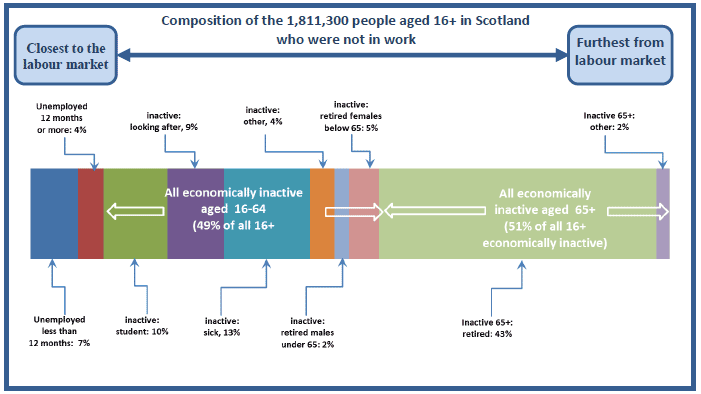
Source: Annual Population Survey, Jan-Dec 2013, ONS
Figure 11 shows the make-up of those individuals aged 16+ who were not in work in 2013. Those who were unemployed make up 11% of the total 16+ population not in work. If we consider only the economically inactive population, those who were over 65 and retired or inactive for other reasons made up 51% of the total 16+ inactive population in Scotland. Considering only those people aged 16-64 who were economically inactive, the largest category was those who were either short or long term sick (31% of all aged 16-64), followed by those who were students (23%). Only 9% of those 16-64 gave their reason for being inactive as being because they were discouraged from working by the availability of jobs, their perceptions of the required skills or other reasons. Females aged below 65 who were retired make up 11% of all aged 16-64 who were inactive, more than double the proportion of males under 65 who were retired. This is primarily a consequence of the age group used to measure the headline inactive cohort (16-64) which currently covers a large number of females who have reached their state pension age. As the state pension age for females increases through time to match the male state pension age, the size of this cohort will decrease.
Sub-section A: Unemployment
Unemployment covers individuals who are not in work, but are available for and actively looking for work. The level of unemployment varies with the economic cycle. For example, when the economy is strong employers create more jobs and unemployment falls. Conversely when the economy is weak, there is a reduction in job opportunities and unemployment rises.
Box 4- Unemployment
Unemployment levels and rates from the Labour Force Survey and the Annual Population Survey (APS) are measured following the internationally agreed definition recommended by the International Labour Organisation (ILO) - an agency of the United Nations. The ILO definition of unemployment covers people who are:
- without a job, want a job, have actively sought work in the last four weeks and are available to start work in the next two weeks; or
- out of work, have found a job and are waiting to start it in the next two weeks.
Unemployment levels cover all workers aged 16 and over.
Unemployment rates are the number of unemployed people expressed as a percentage of the relevant economically active population, normally those aged 16 and over.
The most up to date estimates for unemployment are taken from the Labour Force Survey (LFS) as this provides a more current picture of unemployment in Scotland than the APS. Monthly unemployment data for the countries of the UK can be found in the monthly Labour Market briefing.
Analysis by age, gender
Based on the APS for 2013:
- There were 207,000 people aged 16 or over who were unemployed in Scotland, a decrease 6,000 over the year, but an increase of 76,700 since the start of the recession in 2008.
- The unemployment rate was 7.7% in Scotland, down 0.2 percentage point over the year, but up 2.8 percentage points since 2008.
- In the UK, the unemployment rate was 7.5%, (lower than the rate in Scotland), and down 0.4 percentage points over the year, but up 1.8 percentage points since 2008.
- Just under 4 in 10 of all unemployed people in Scotland are aged 16-24, a higher proportion than for any of the other age groups. The majority (59%) of these unemployed 16-24 year olds are males.
- The youth unemployment rate is the highest of all the age groups. The youth unemployment rate (16-24) in Scotland was 20.6%, 0.5 percentage points higher than the rate in the UK. The rate in Scotland has increased by 7.0 percentage points since 2008, higher than the increase of 5.1 percentage points in the UK over the same period.
- Excluding those 16-24 year olds in full-time education, the employment rate in 2013 was 68.6% in Scotland, higher than the rate seen across the UK (68.0%).
Figure 12: Comparison of unemployment rates by gender in Scotland and UK, 2013
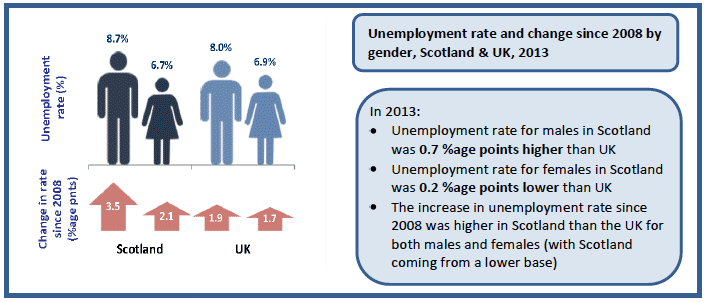
Source: Annual Population Survey, Jan-Dec 2013, ONS
Figure 13: Comparison of unemployment rates by age in Scotland and UK, 2013
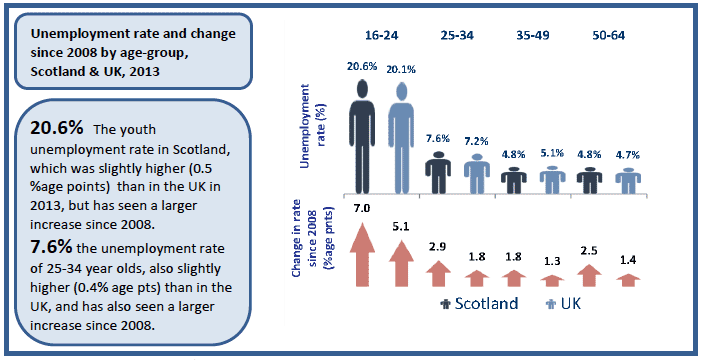
Source: Annual Population Survey, Jan-Dec 2013, ONS
Analysis by age and duration
Chart 8 shows how duration of unemployment varies across different age groups.
- Just over 47% (98,100) of all unemployed people in Scotland have been unemployed for less than 6 months, while just over 35% (73,100) have been unemployed for 12 months or more, of which, just under two-thirds (47,600) are males.
- The youth unemployment rate (20.6%) is the highest of all the age groups. However, of those unemployed, they are the least likely age group (at 11.6%) to be unemployed for 24 months or more. 27.9% of 50+ age group have been unemployed for 24 months or more, the highest of all the age groups.
Chart 8: Duration of unemployed by age, Scotland, 2013
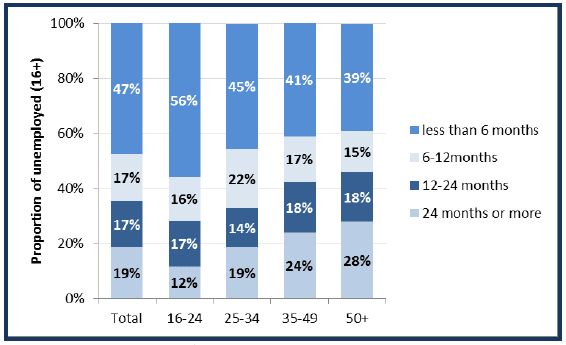
Source: Annual Population Survey, Jan-Dec 2013, ONS
Unemployment levels and rates by gender and age for 2004 to 2013 are provided in the web tables. Duration of unemployment data is also provided in the web-tables.
Local Authority area level analysis - Model based unemployment
Given that the unemployed are a relatively small sub-group of the total population, their sample sizes in the APS datasets are also small and thus have large sampling variability. To improve the quality and reliability of unemployment estimates for all local authorities, the Office for National Statistics (ONS) developed model-based unemployment estimates, as outlined in Box 6.
Box 5 - Model based unemployment
In 2003, ONS developed a statistical model to improve small area estimates of unemployment by using supplementary information from the claimant count - a count of the number of people claiming Jobseeker's Allowance. As it is an administrative measure, accurate information is known for all areas. It is also highly correlated with unemployment. The model is said to borrow strength from the claimant count. The model also includes a socio-economic indicator and a random area effect.
More information about the modelling methodology can be found here:
Figure 14: Model Based Unemployment (MBU) across Local Authority areas in Scotland, 2013
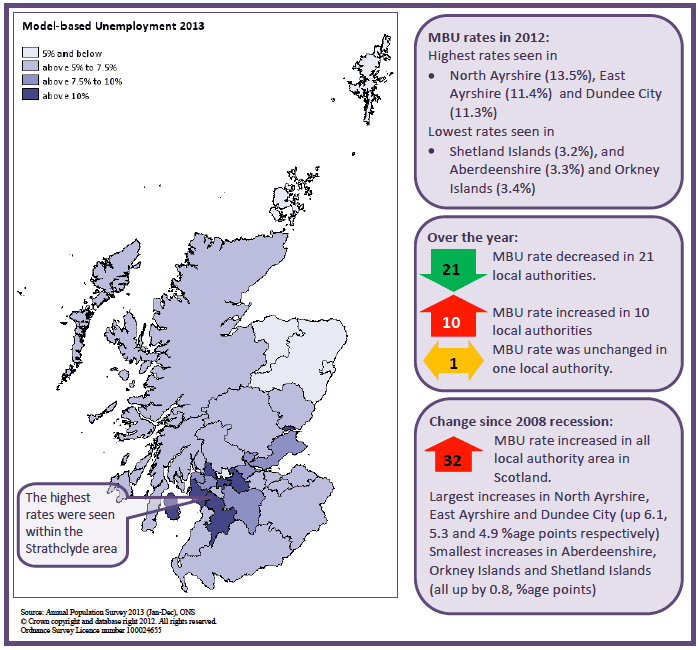
Source: Annual Population Survey, Jan-Dec 2013, ONS
Model based unemployment levels and rates for 2007, 2008, 2012 and 2013 are provided in Annex A, with a full time series available in the web tables.
16 to 19 year olds Not in Employment, Education or Training (NEET)
Figure 15 shows how the NEET group has changed in Scotland between 2004 and 2013.
In 2013, 29,000 (11.9%) of 16-19 year olds were not in education, employment or training. The proportion NEET has decreased by 1.4 percentage points (down 4,000) since 2012; this change is not statistically significant[10]. This decrease is being driven by a decrease in the number of NEET males; in 2013, 15,000 (11.8%) males were NEET, down 4,000 (3.1 percentage points) since 2012. For females, in 2013, 14,000 (12.0%) were NEET, the level is unchanged from 2012 (however, the rate increased by 0.3 percentage points since 2012). 2013 is the first year that the proportion of NEET females is above that of males (0.1 percentage points of a difference in 2013).
Figure 15: Percentage of 16-19 year olds NEET by gender, Scotland, 2004-2013
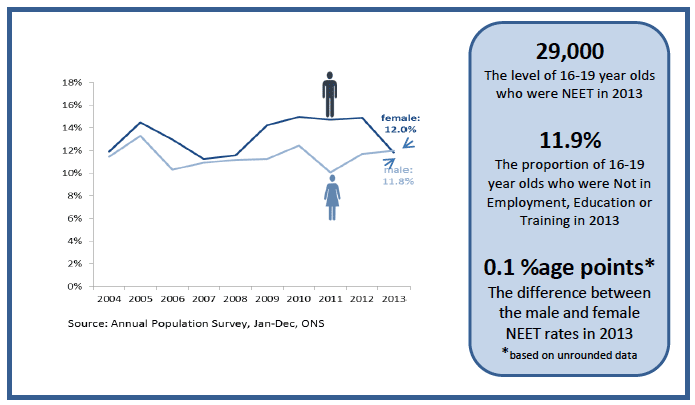
Levels and proportions of NEET by gender for 2004 to 2013 are provided in Annex A and the web tables.
Box 6 - Measuring the NEET group
In 2006 the Scottish Government commissioned the Training and Employment Research Unit (TERU) at Glasgow University to explore different ways of measuring the NEET group and present recommendations on the best measurement options. The following recommendations were made:
At Scotland level:
The Annual Population Survey (APS) is the recommended source to measure the size of the NEET group in Scotland.
At Local Authority level:
A combination of DWP benefits data and school leavers destinations data should be used to monitor the NEET group at a local level. Information on levels and rates of known NEET at local authority level for 2004 to 2013[11] can be accessed at: http://www.scotland.gov.uk/Topics/Statistics/Browse/Labour-Market/MCMCLMSTATS
The full report outlining the work and recommendations made by TERU can be found at: http://www.scotland.gov.uk/publications/2006/07/28090808/0
Recent developments
Historically, it has been difficult to make robust conclusions when comparing proportions of young people NEET internationally, due to differing definitions of NEET.
ONS, with other UK administrations and departments have agreed a consistent methodology for defining whether a young person is NEET and this methodology has been adopted for this publication. Although this methodology uses a different combination of LFS/APS variables compared to the methodology used in previous years by the Scottish Government, the results are very similar.
The Scottish Government focuses on 16-19 year olds in this publications as this is the age group at which policy interventions are targeted at present.
Sub-Section B: Economic Inactivity
Economic inactivity covers individuals who are neither in employment nor unemployed. There are many reasons why people may be inactive. For example, they may have a long-term illness or disability, be studying for a qualification, staying at home to look after their family, or have retired. The economically inactive population are not part of the supply of labour. However, the labour market is dynamic, with people continuously moving between different categories. Therefore it is important to consider inactivity figures as they include those who may make up the labour supply in the future and those who were part of the labour supply in the past.
Box 7 - Economic Inactivity
Economically inactive people are not in employment, but do not satisfy the internationally agreed definition of unemployment. This group covers people without a job who:
- want a job but have not been seeking work in the last four weeks; or
- want a job and are seeking work but not available to start work in the next two weeks; or
- do not want a job.
Headline Inactivity levels and rates cover all workers aged 16-64 for both men and women. This excludes many people who would be inactive due to retirement, although still captures a large number of people in early retirement.
Figure 16: Economic Inactivity, Scotland and UK
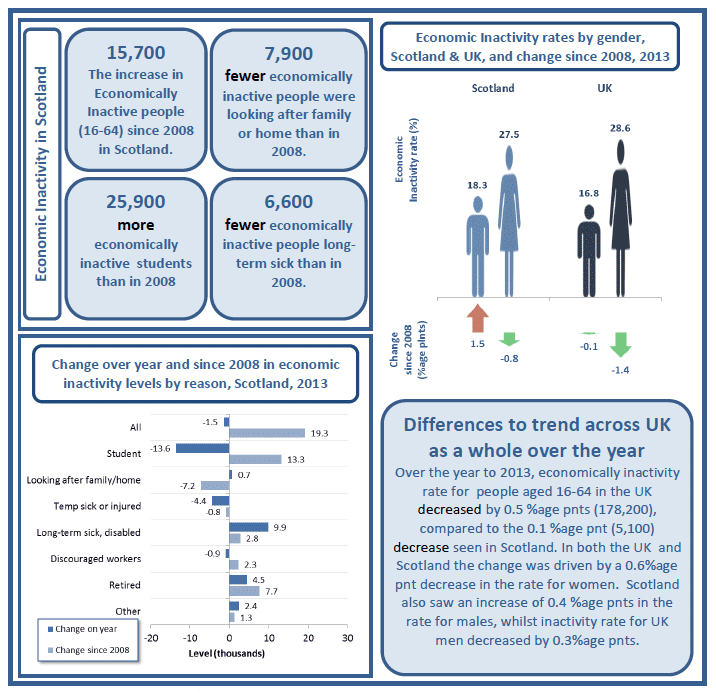
Source: Annual Population Survey, Jan-Dec 2013, ONS
Scotland and UK:
- Over the year to January to December 2013, the economic inactivity rate for those aged 16-64 in Scotland decreased by 0.1 percentage point to 23.0% (down 5,100 to 779,800)
- Economic inactivity rate for Scotland has increased by 0.3 percentage points since 2008 recession (up 15,700), driven by a 1.5 percentage point increase in the inactivity rate for men.
- In the UK, the economic inactivity rate (16-64) decreased by 0.5 percentage points over the year to 22.7% and has decreased by 0.8 percentage points since 2008.
Inactivity in Scotland by gender:
- Male inactivity levels increased over the year by 6,100, with the rate increasing by 0.4 percentage points to 18.3%. Since 2008 recession, male inactivity levels have risen by 26,600 (up 1.5 percentage points).
- Historically female inactivity levels have been higher in comparison to male inactivity levels. Over the year to 2013 female inactivity levels reduced by 11,200, with their rate decreasing 0.6 percentage points to 27.5%. Since 2008 recession, female inactivity rates have fallen by 10,900 (down 0.8 percentage points).
Inactivity in Scotland by age
Inactivity rates tend to be higher for the 16-24, 50-64 and 65+ age groups. The reason for higher inactivity rates in the 16-24 age group is due to greater numbers being enrolled in full-time education. Higher inactivity rates for 50-64 and 65+ age groups is a result of greater levels of sickness and retired people.
- Inactivity rates for 16-24 increased by 0.9 percentage points over the year to 33.7%, with the level increasing by 3,100 to 199,900, driven by small increases across several categories, and somewhat offset by a reduction in the level of inactive students (down 7,800).
- Excluding those in full-time education, the inactivity rate for 16-24 year olds in was 15.5%, lower than the UK inactivity rate of 16.6%.
- Inactivity rates for those aged 25-49 increased slightly by 0.1 percentage point over the year to 14.2%.
- For those aged 50-64 and 65+, inactivity rates fell by 1.0 and 0.5 percentage points respectively. However, while the level for 50-64 year olds has also reduced (down 8,200), the level for 65+ increased (up 16,200). The reduction in the rate for 65+ was due to the total 65+ population increasing by a greater amount than the 65+ inactive population (e.g. the increase in economically active people age 65+ was greater than the increase in economically inactive people aged 65+).
Economic Inactivity at Local Authority level
Figure 17: Economic Inactivity by Local Authority, 2013
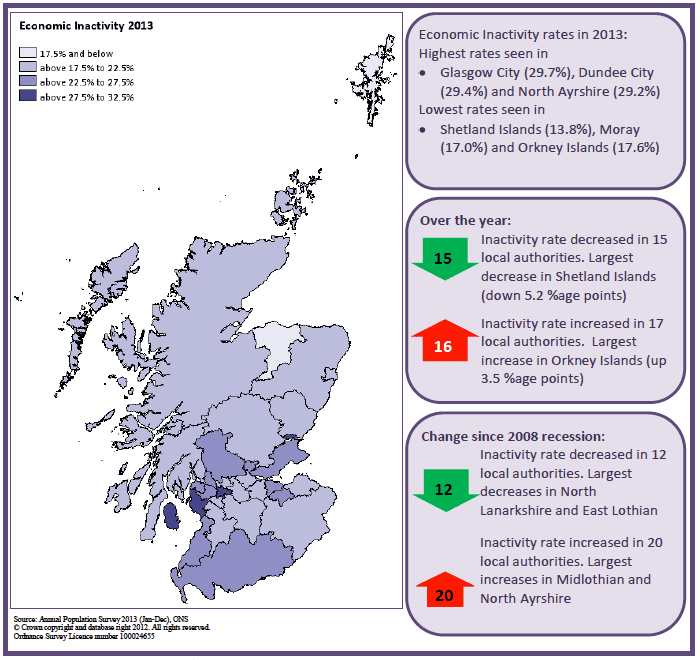
Source: Annual Population Survey, Jan-Dec 2013, ONS
Table 9 in Annex A gives the economic inactivity rate for the population aged 16 to 64 in Scotland's local authorities for 2008, 2012 and 2013. A full time series back to 2004 can be downloaded from the web-tables and SNS.
The relationship between unemployment rates and inactivity rates is complex. The higher the level of inactivity within an area, the lower the level of economic activity (the sum of employment and unemployment). The unemployment rate is calculated using the number of economically active people as a denominator; consequently in areas where there are high levels of inactivity, the unemployment rate is also higher.
Chart 9 shows how economic inactivity rates have changed across Scotland's local authority areas since 2008 recession.
Chart 9: Inactivity rate for people aged 16-64 by local authority, Scotland, Change from 2008 to 2013
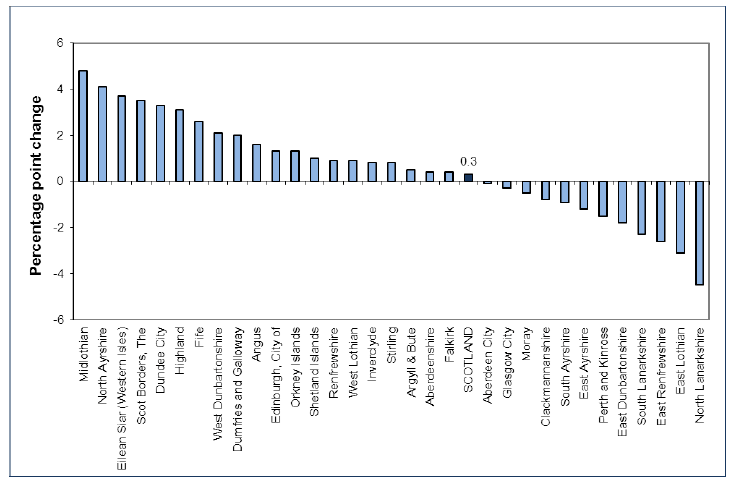
Source: Annual Population Survey, Jan-Dec 2013, ONS
Between 2008 and 2013 in Scotland:
- The largest increases in inactivity rate were seen in Midlothian, North Ayrshire and Eilean Siar (up 4.8, 4.1 and 3.7 percentage points respectively)
- The largest decreases in inactivity rate were seen in North Lanarkshire, East Lothian and East Renfrewshire (down by 4.5, 3.1 and 2.6 percentage points respectively).
Reasons for inactivity
Respondents in the APS are asked to provide a reason as to why they are not in employment or unemployed. Figure 16 includes a chart showing change in level for reasons for inactivity since 2008 and over the year.
The largest group within the economically inactive population is those stating they have a long-term sickness or disability. The relative size of this group has reduced slowly from 30.2% in 2008 to 28.8% in 2013.
- At a local authority level, North Lanarkshire, West Dunbartonshire and South Lanarkshire had the highest percentages of inactive population stating they were long-term sick in 2013, all greater than 37%.
Those looking after the family or home make up just over a fifth (20.4%) of the inactive population, having reduced slightly (1.3 percentage points) from 21.7% in 2008.
- Midlothian, Aberdeenshire and Highland had the highest percentages of those inactive due to looking after family or home (33.3%, 29.0% and 26.3% respectively).
Students are the other main inactive group, accounting for 23.3% of the inactive population in 2013. The relative size of this group had grown from 20.4% in 2008. The overall size of this group has increased by 16.6%, from 155,800 in 2008, to 181,700 in 2013.
- Only seven local authorities had a higher percentage of students in their inactive population than the national average in 2013. These include the main university cities (Aberdeen, Dundee, Edinburgh, Glasgow and Stirling), as well as East Dunbartonshire, East Renfrewshire and Fife.
Retired people accounted for 16.0% of the inactive population aged 16-64 in Scotland in 2013.
- 20 local authorities had higher percentages of retired inactive people than the national average. Those with the highest percentages were Clackmannanshire, East Dunbartonshire and South Ayrshire. In contrast, Glasgow and Edinburgh have amongst the lowest percentages of inactive retired people, a reflection of the different age demographic within these local authorities.
More detailed information on reasons for inactivity by local authority is provided in the web tables
Willingness to work
People who are inactive may have a willingness to work but are not available or able to do so. The proportion of all people in Scotland aged 16-64 who were inactive, wanted to work increased from 25.4% in 2012 to 25.7% in 2013. There are now
11,900 more people in Scotland aged 16-64 who were inactive and wanted to work since 2008 recession (up 1.1 percentage points).
Within local authorities the percentage of inactive people wanting to work in 2013 was highest in Aberdeen City, Moray and Angus, where the percentage of inactive people said they would like to work was 38.4%, 38.1% and 33.7% respectively. Table 10 shows the number and percentage of those who are inactive but want to work for 2008, 2012 and 2013, with a full time series available in the web-tables.
Adults who have never worked.
The APS asks those who did no paid or unpaid work if they have ever had a paid job or place on a government training scheme. As many younger people do not enter the labour market until after leaving full-time education, the chances of a person having ever worked[12] is highly dependent on their age
Figure 18: Number of people aged 16 and over who have never worked, Scotland, 2004 - 2013
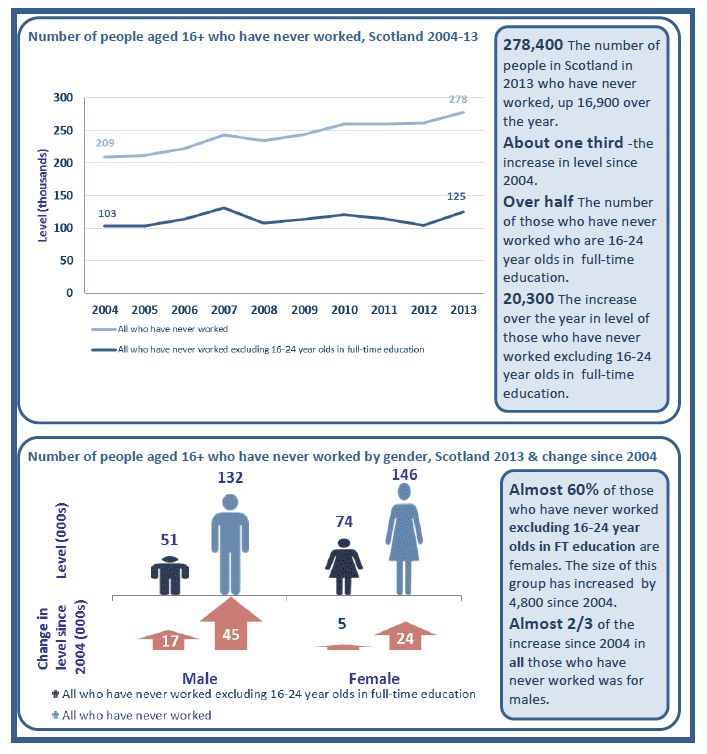
Source: Annual Population Survey, Jan-Dec 2013, ONS
Figure 18 shows how the level of those who have never had a paid or unpaid job has changed between 2004 and 2013.
- The number of people aged 16 and over in Scotland who have never worked has been gradually increasing since 2004.
- Over a half of these people are 16-24 year olds in full-time education. If this group is excluded, the figure for 2013 decreases to 124,800, which represents a 16.4% increase on the 2008 level (107,200) and a 21.4% increase on the 2004 level (102,800).
- The number of people aged 25-49 in Scotland who have never worked has risen by just under 42% since 2004, from 33,500 to 47,500 in 2013, whereas the number of people aged 50 and over who have never worked has fallen from 32,900 in 2004 to 25,500 in 2013.
- Reasons people may never have had a paid or unpaid job include being a student (in full-time education), looking after family or home and being long-term sick or disabled.
- Since 2008, the number of people aged 16 and over who have never had a paid or unpaid job has increased in 23 of Scotland's local authorities.
Data for those who have never worked at local authority level is available from the web tables.
Contact
Email: Alan Winetrobe
There is a problem
Thanks for your feedback